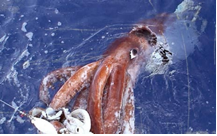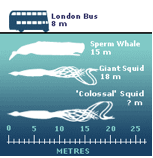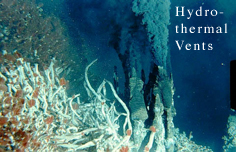By: Jessica Wurzbacher, MSc
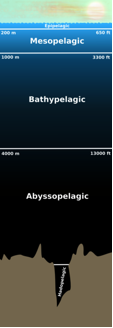 It is said that we know more about the moon, (on average 235,000 miles above), that we do about the deep sea (about 2.5 miles below), but what we do know about the deep sea is astounding and the creatures unimaginable.
It is said that we know more about the moon, (on average 235,000 miles above), that we do about the deep sea (about 2.5 miles below), but what we do know about the deep sea is astounding and the creatures unimaginable.
The deep sea is an extremely harsh environment. It is dark, below 200m the light levels are too low for photosynthesis (the twilight zone), and not a glimmer of sunlight remains beyond 1,000m (the midnight zone). The water is very cold (37-50oF/3-10oC) and consequently has low levels of oxygen. The pressure at a depth of 2.5 miles is about 400 atmospheres, 400 times the pressure on the surface and equivalent to half a tonne per square centimeter. The density of organisms is therefore low.
25% of the estimated 8,700,000 species on earth live in the ocean depths, and 91% of those have yet to be discovered, described and catalogued (CoML). Many of these could potentially hold cures and new treatments for cancer, arthritis and other diseases.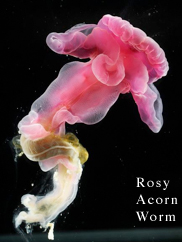
Adaptations to deal with the low density of food
The organisms of the deep sea are truly amazing and extraordinary, with every journey down uncovering more of the mysteries. This month a study published in Proceedings B of the Royal Society described a new species of deepwater acorn worms found 2,700m deep near the Mid-Atlantic Ridge with extremely long “lips” to help them capture prey in a habitat deficient of food.
Living in an environment where food is scarce, organisms need to be able to eat anything and everything that comes their way, the fangtooth (Anoplogaster cornuta) accomplishes this with its large cavernous mouth, and large dagger-like teeth (in fact, the teeth are so large is it difficult to close it’s mouth).
Adaptations to deal with the low density of mates
 The deep sea anglerfish (Melanocetus johnsoni) is aptly named for its elongated dorsal spine that extends forwards and lures prey towards it’s wide mouth and sharp teeth, with a glowing lure (containing bioluminescent symbiotic bacteria). The density of organisms in the deep sea is so low, that finding a mate in the right place at the right time can be quite a challenge. To avoid this potential problem, when they do meet, the male anglerfish will bite onto the female, their blood vessels fuse, and he will spend the rest of his life as a sperm producing appendage.
The deep sea anglerfish (Melanocetus johnsoni) is aptly named for its elongated dorsal spine that extends forwards and lures prey towards it’s wide mouth and sharp teeth, with a glowing lure (containing bioluminescent symbiotic bacteria). The density of organisms in the deep sea is so low, that finding a mate in the right place at the right time can be quite a challenge. To avoid this potential problem, when they do meet, the male anglerfish will bite onto the female, their blood vessels fuse, and he will spend the rest of his life as a sperm producing appendage.
Adaptations to deal with the lack of Light
In the mesopelagic (twilight zone) where light levels are low, large eyes and reflective retinas are advantageous to make use of any vestiges of sunlight that penetrate down.
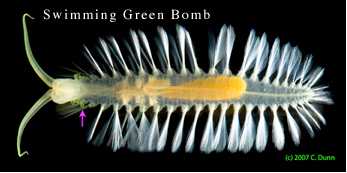 Many deep sea fish possess photophores (light producing organs), these aid in species identification, attracting food, or deterring predators. The lanternfish (small mesopelagic fish of the family Myctophidae) have photophores paired and concentrated in rows on their body and head in species-specific patterns. In some the pattern varies between males and females, with males having concentrations of photophores above the tail, and females below.
Many deep sea fish possess photophores (light producing organs), these aid in species identification, attracting food, or deterring predators. The lanternfish (small mesopelagic fish of the family Myctophidae) have photophores paired and concentrated in rows on their body and head in species-specific patterns. In some the pattern varies between males and females, with males having concentrations of photophores above the tail, and females below.
The Swimming Green Bomb (Swima bombiviridis) discovered in 2009, armed with “bombs” (shown by the arrow) that glow a brilliant green when dropped, which they use as a distraction tactic to escape 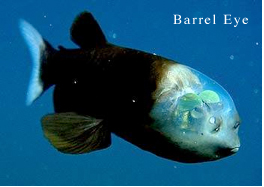 predators.
predators.
The Barrel Eye (Macropinna microstoma) is certainly a bizarre looking creature, with two green rotating eyes embedded in their transparent head. The dark “eye” like patches are in fact olfactory organs. Watch the video link to see this unique organisms in action.
Due to the lack of light even further below becomes a less important sense, and in many fish their eyes are considerably reduced, or even degenerate.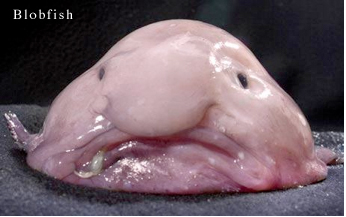
Adaptations to deal with the high pressure
Winning the most awards for “ugliest fish” – the Blobfish (Psychrolutes marcidus). This “grumpy”, “frowning” “blob” is able to withstand crushing pressure at 1,000m as its body is mostly a gelatinous mass with a density just less than water. It hovers with minimal energy expenditure just above the sea floor waiting for passing food particles
Despite their monstrous impression, the fish in the deep sea are only 5-6 inches long. The situation is not the same however in deep sea invertebrate where marine gigantism is common. The reason for these colossal sizes is not really known, it has been proposed that it could be due to:

- A slower metabolism, due to lower temperatures, so therefore organisms live longer and can grow larger.
- A larger size and lower surface area to mass ratio creates advantages in body temperature regulation
- Scarcer food resources delay sexual maturity and result in a larger size
- Higher pressure could have an effect
The Deep sea squid (Architeuthis dux) is about 42ft long, with the largest known specimen reaching an astonishing 59ft long. So elusive, the first photograph of a live giant squid was only captured in 2004, and filmed in 2006. Rarely seen by humans, but a preferred menu items for Sperm Whales.
Chemosynthesis and hydrothermal vents
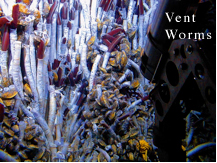 In 1977 a unique ecosystem was discovered 1 mile below the surface. In a vast and barren environment devoid of light, a rich, thriving community independent on the energy in sunlight was found. Hydrothermal vents are cracks in the ocean floor, near mid-ocean ridges (divergent plate boundaries) that emit super-heated water rich in minerals. Bacteria living in these communities use hydrogen sulfide, toxic to most other marine life, and convert it to organic molecules in a process called chemosynthesis. This is the base of food chains at hydrothermal vents.
In 1977 a unique ecosystem was discovered 1 mile below the surface. In a vast and barren environment devoid of light, a rich, thriving community independent on the energy in sunlight was found. Hydrothermal vents are cracks in the ocean floor, near mid-ocean ridges (divergent plate boundaries) that emit super-heated water rich in minerals. Bacteria living in these communities use hydrogen sulfide, toxic to most other marine life, and convert it to organic molecules in a process called chemosynthesis. This is the base of food chains at hydrothermal vents.
Hydrothermal vents are covered in tube worm that form a symbiotic mutualistic relationship with chemosynthetic bacteria. The bacteria live in the worm tissue protected by their hard shell, and in return provide the worm with an organic food source, in an otherwise barren area. As adults these tube worms have no mouth or digestive system, and rely fully on this mutually beneficial relationship. They are so well nourished that they are actually the fastest growing invertebrate, growing 2m a year.
These unique organisms have many intriguing properties; with their ability to convert toxic chemicals to harmless compounds could we use them to clean up hazardous waste? Could the enzymes that function as such high temperatures be isolated and given an industrial use? Could they indicate the prospect for extra-terrestrial life on poorly lit but geologically active planets, especially as the first life forms on our planet are thought to have been chemosynthetic?
Hydrogen Sulfide is just one of three energy sources discovered at hydrothermal vents. A second energy source discovered was methane which seeps out of cracks in the sea floor at hydrothermal vents and at cold seeps, where methane oxidizing bacteria living inside deep-sea mussels have fueled thriving ecosystems, once again devoid of light.
Hydrogen fuel cells have been proposed as an alternative energy source to meet our energy needs from cars to generators, but they remain expensive, complicated and relatively rare. Deep sea bacteria have already solved the problem. Mussels (Bathymodiolus puteoserpentis) containing hydrogen-oxidizing symbionts have been identified and there is potential for scientist to be able to clone these hydrogen consuming bacteria to create all-natural hydrogen fuel cells.
Pollution in the Deep Sea
It seems that nowhere on our planet can escape the wrath mankind’s destruction. Back in 2008 manmade chemical pollutants were found in deep sea octopus and squid from 1,000 to 2,000m deep. Among the chemicals detected were PCBs and DDT, known as persistent organic pollutants that do not degrade and can persist in the environment for a very long time.
Hydrothermal vents are sources of many valuable metals, such as copper, nickel and cobalt, all used in cell phones, laptops and batteries. The inaccessibility of the deep sea floor has protected these environments, but now with the technological developments and submersibles, the potentially for mining is now becoming a viable option. The environmental concerns are considerable, and highlighted by the Gulf Oil Spill, where correcting problems at depths of 1,500m becomes extremely difficult. The potential conflict between the ecosystem and the economics becomes huge.
As fisheries are becoming exhausted close to shore, fishermen are looking further out to sea and at greater depths to find their catch. Advances in technology and the ability to drag nets several hundred feet below the surface is threatening these slow growing and late maturing species. One common technique to capture these fish is trawling, and the nets can cause considerable benthic damage as they are dragged over the delicate substrate at seamounts and other areas where deep sea fish congregate.
The deep sea is a forgotten realm, a mystery to many of us. It is hard to imagine life 2.5 miles down below as we enjoy our time out sailing, boating, swimming and playing on the surface, but take a moment to think about what lurks beneath!
What can you do?
- Support ocean conservation by supporting Ocean Crusaders
- Correctly dispose of waste, trash and chemicals
- Avoid eating fish caught by destructive trawling techniques.
- Remember that “out of sight” should not mean “out of mind”

